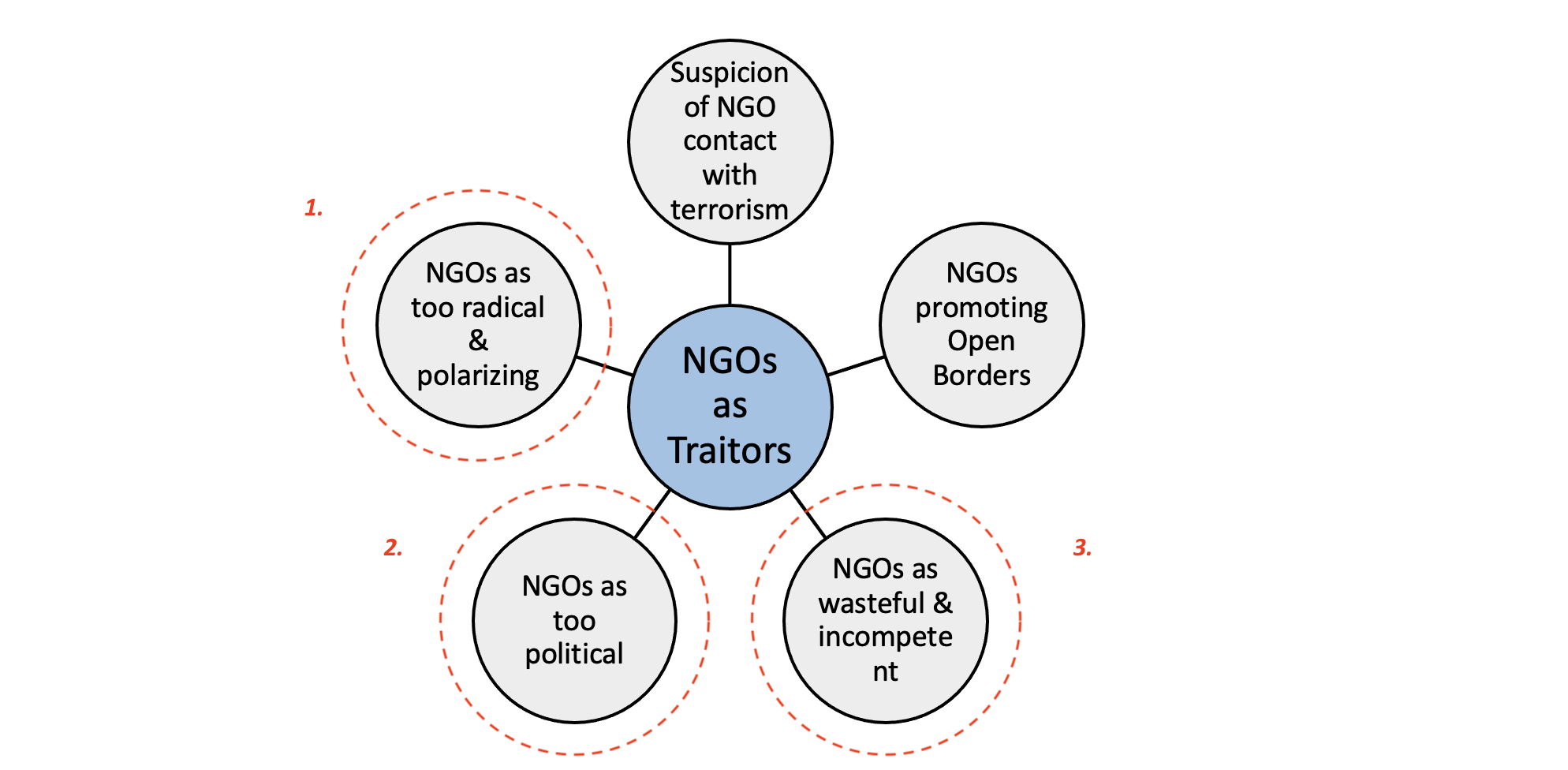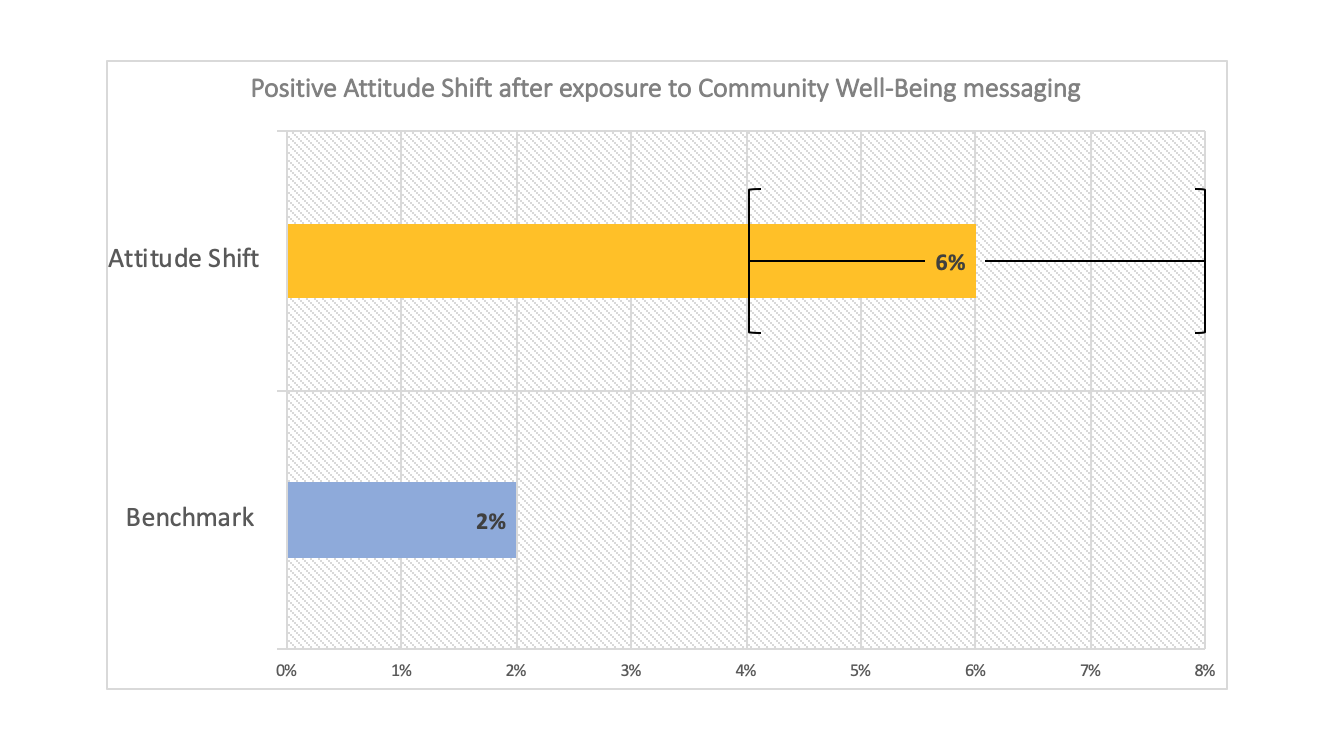Section 5 - Reframing to immunise – approach & results
The questions answered in this section are:
- How do people respond to the threat of conspiracy thinking and what role does narrative immunisation play in a broader response strategy?
- And more specifically, how have we used the approach in the Proactive Protection project and what were the outcomes?
5.1 Responding to conspiracy theories
The natural instinct on hearing a conspiracy theory is to question the evidence and/or present other evidence that undermines the position presented. What is particularly challenging in responding to conspiracy thinking is the self-sealing quality of the argument, i.e. new evidence presented from established sources is just further evidence of the conspiracy to the believer1
. Also given the strong level of social attachment of certain groups to conspiracy theories, strong attacks on the argument can backfire to make those holding them even more committed2
. Put simply, myth busting seldom works and can even backfire. So in any direct engagement-led response like other narrative change processes, an emotionally-smart response is key.
Looking more broadly, what are the established response practices? The Handbook of Conspiracy Theories provides a solid overview of the kinds of actions that are commonly used in response to the spread of conspiracy theories from the supply side (those who spread conspiracy thinking) to the demand side (those who consume them). On the supply side, the actions include taking down or blocking websites, downgrading sources spreading conspiracy thinking in the algorithm, marking or tagging websites, users and posts as conspiracy theorists, and factchecking projects3
.
The focus our project is very much on the demand side and trying to directly engage people who are exposed to conspiracy thinking. On this side, there are many ways to respond including prebunking/inoculation4
and debunking/factchecking, longer term responses such as building media literacy and civic education and of course, more public information/campaigning responses like narrative change to immunise or reduce harm.
5.2 Narrative immunisation
The basic assumptions about an immunising solution in this project is based on the idea that:
Following these principles in more practical terms, our project is based on the idea that reframing the public debate around NGOs in a more positive direction based on shared values of community well-being will help to reduce distrust and uncertainty about civil society in our target segments, and so immunise them from more extreme ideas like the idea of NGOs as ‘traitors’ central to the Great Replacement. Indeed, we have previously seen that narrative change approaches do work to rebuild trust in NGOs among movable middle audiences in our projects in Kazakhstan6
and others also report success in this area7
.
5.3 Project Result: Narrative immunisation will work with the Detached, and not the Disillusioned.
As stated above, the basic assumptions about an immunising solution in this project is based on the idea that a positively-focused narrative approach can rebuild trust in the NGO sector. After the testing phase in 2024, we decided based on the results that the Detached should be our main focus for the immunisation strategy as it worked well with them, in comparison to the Disillusioned.
While the message testing survey data in 2024 didn’t show much difference in response to the community well-being messaging between the 2 segments, what came out really clearly in the focus groups (in both 2023 and 2024), was that the feelings of uncertainty, powerlessness and lack of control/agency were in fact much stronger in the Disillusioned than the Detached. For example, when we tested positive NGO messaging in video content in the focus groups in 2023, it worked well with the Detached, whereas the conspiracy theorist-led responses of the Disillusioned groups meant that they initially liked the message, but very quickly began to question everything within a conspiracy/corruption frame. Our way to summarise this was that the Disillusioned group couldn’t handle the positivity. So overall for the Disillusioned, there can be a relatively wide range of opinions about NGO work in an initial response, but ultimately the group is quickly convinced by a conspiracy view as the discussion unfolds, i.e. immunisation or rebuilding of trust doesn’t happen.
Taking a broader view on the Disillusioned and to quote our NGO partners who also observed the 2023 focus groups: “they are aching for community”. So, we really think that more community-based, direct engagement and interaction is needed for this group to help them find some agency to reduce their anxiety about their futures and more broadly, begin to rebuild more trust in institutions.
5.4 Project Result: Narrative Immunisation worked among the Detached
The following key results that show immunisation against conspiracy thinking about NGOs using community well-being messaging was achieved among the Detached.
To build an immunisation strategy, we first identified the most influential pathway narratives which we need to positively shift opinion among the Detached to immunise them from the ‘traitor’ narrative. From the 5 pathway narratives we found in the opening narrative mapping phase, we identified 3 key pathway narratives: that NGOs 1. were too political, 2. too extreme and 3. incompetent and wasteful. The Detached held stronger negative opinions in the 2023 survey on these 3 narratives (in comparison to the other 2 pathways) and also, they brought up these 3 themselves (without prompting) in discussions about NGOs in the 2023 Focus groups.

Figure 10: Immunisation Strategy - 3 key pathway narratives to immunise the Detached
Interestingly and more positively, there was significant support for the humanitarian message of saving people in trouble in the Mediterranean (The Open Borders pathway) and basically disagreement on the contact with terrorism pathway. They also did not bring up the traitor narrative at all in focus groups and also disagreed with it in the 2023 survey.
5.5 Project Result: Community well-being messaging built more trust to immunise the Detached
Using the community well-being messaging (link), we were able to shift average attitudes on a positive wording of the 3 key pathway narratives and a trust statement on NGOs from ‘tend to disagree/unsure’ response range in 2023 to the ‘tend to agree’ response range in the 2024 survey.

Figure 11: Positive attitude shift in response to Community-Well Being messaging among the Detached on 3 Key Pathway Narratives from 2023 to 2024
In addition, to confirm these overall results, we did a small experiment in the 2024 message testing survey, where we saw that attitudes among the Detached shifted on the 3 key pathway narratives and a trust statement on average by 6% in the positive after being exposed to the community well-being messaging, in comparison to a Detached control group who were not exposed to it.

Figure 12: Positive attitude shift on Key Pathway Narratives based on Experimental approach
This experimental element certainly has its limitations and would need to be repeated with larger sample sizes (as we did in the #KommMit pilot), but it helps to triangulate and validate the attitude shift we see in the longer term immunisation result above.
To be clear, it is unrealistic to expect to turn the Detached in unabashed NGO supporters through one narrative intervention. However, this result of a 6 to 10-point shift in the key pathway narratives is enough to keep the ‘traitor’ narrative in the category of unacceptable/extremist thinking for them, i.e. serving the immunising goal at the heart of our project.
<-- Section 4 - Target Segments | Section 6 - Messaging -->
- 1COMPACT (2020) Expert guide to conspiracy theories. A podcast series on The Conversation’s Anthill & Comparative Analysis of Conspiracy Theories in Europe (COMPACT) Project Website.
- 2Antonio Amadeu Stiftung (2015) "NO WORLD ORDER": How anti-Semitic conspiracy ideologies transfigure the world Wie antisemitische Verschwörungsideologien die Welt verklären.
- 3Kreko, Peter (2020) ‘Countering conspiracy theories’ In Butter and Knight Routledge Handbook on Conspiracy Theories, p. 242 to 255.
- 4Giving people the tools and critical insight to recognise and resist a conspiracy theory before they see it, e.g. Beth Goldberg (2021) Inoculation Theory: A Beginners Guide. Innoculation Science Website.
- 5Kreko, Peter (2020) ‘Countering conspiracy theories’ In Butter and Knight Routledge Handbook on Conspiracy Theories, p. 242 to 255.
- 6A narrative change pilot we supported in Kazakhstan moved middle opinion +6 points in a positive on NGO trust.
- 7Israel Butler, Liberties (2021) How to talk about civic space: a guide for progressive civil society facing smear campaigns; Lifeline (2022) Reanimating civil society: A Lifeline guide for Narrative Change